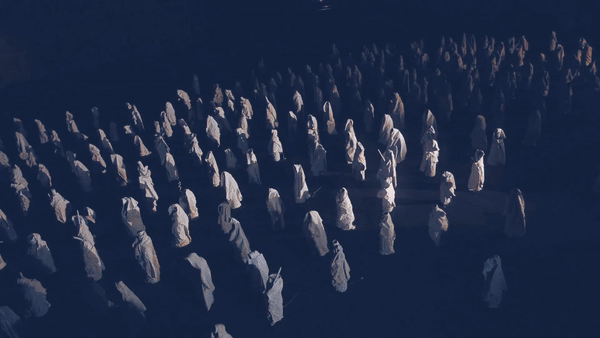Deelstra’s installation People (2019), consisting of a staggering four hundred sculptures, serves as a blank canvas upon which the viewer can project their personal perspective on migration. Whether these sculptures evoke a sense of vulnerability, intimidation, humour,
or comfort, Deelstra aims to keep interpretation open-ended and free from bias.
The sculptures are largely constructed from archaeological finds collected by Rolf Baron, Deelstra’s grandfather, unearthed in Europe some thirty years ago. These sculptures contain bones, cutlery, pipes, and medicine bottles from the 19th and 20th centuries. The sculptures bear the symbolic remnants of a ‘Europe of the past’. Just as every migrant carries a piece of culture with them, Jonat’s unique sculptures do the same. They seem both fragile and eternal.
Deelstra: ‘Migration, an age-old phenomenon, typically evokes profound emotions and serves as a striking example of deep societal division. In the media, a black-and-white portrayal is of- ten presented, where citizens feel compelled to take sides. A balanced and nuanced approach appears to be in short supply.’
With People, Deelstra explores the complex issue of migration, specifically raising the question of how we perceive this phenomenon. While the scale of migration may seem daunting, this installation reminds us that behind these numbers are individual stories that often evoke feelings of empathy. The installation consists of an impressive caravan of four hundred plaster sculptures. The question that arises is whether People serves as the tangible expression of our inner conflict or is it simply
a timeless representation of this universal phenomenon?
Deelstra: ‘Initially, People consisted of twenty sculptures. The work expanded to eighty, and now there are more than four hundred. The increasing number of sculptures was necessary to sharpen the contrast between the collective and the individual. The figures should function as individuals but, together, almost become statistical. The caravan is positioned in exhibition spaces in such a way that when visitors enter, they see the backs of the individuals, creating the impression of one large mass.’
‘Only when visitors walk around the installation do the sculptures reveal their faces. It can
be deeply moving. I saw tears in the eyes of individuals as they moved past the installation. During another exhibition, someone said that they were fine with immigration as long as they didn’t come here. Another visitor took offense, and the two nearly started to fight; I had to remove them from the room. That, to me, was a great honour: to make people cry and fight through art.’
Short documentary about People - Camera and montage: Peter Balm

















